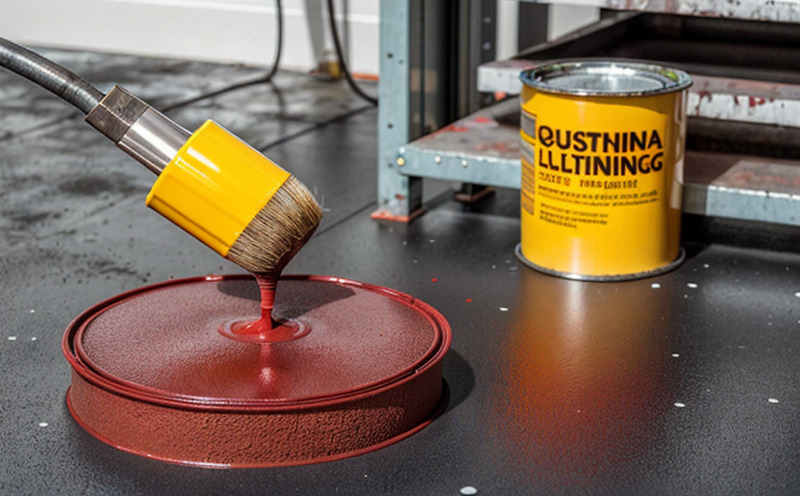DIN EN ISO 2409 Cross Cut Adhesion Testing
The DIN EN ISO 2409 cross cut adhesion testing method is a standardized procedure used to evaluate the bond strength between coatings and substrates. This test is particularly useful in industrial manufacturing, where surface finishing plays a critical role in ensuring product durability and performance.
This method involves cutting small "X" patterns into the coated surface using a specialized tool, which allows for the examination of the coating's adhesion to the substrate under stress. The cross cuts are made at specific intervals, creating a grid pattern that can be observed after immersion or exposure tests. This testing is crucial in industries such as automotive, aerospace, and construction where the integrity of coatings directly impacts product reliability.
The DIN EN ISO 2409 standard specifies precise dimensions for the cut pattern, ensuring consistency across different laboratories. The test is typically performed on a variety of substrates including metals, plastics, and composites, with different coating materials such as paints, varnishes, and primers being tested. This method helps ensure that coatings meet the required adhesion standards to withstand environmental stressors and mechanical loads.
The process begins by preparing the substrate according to the specified requirements. The coating is then applied following manufacturer guidelines or industry best practices. Once the coating has cured, the cross cut pattern is created using a specialized tool. After this initial step, specimens are subjected to various tests such as immersion in solvents, exposure to UV light, or mechanical abrasion.
Following these environmental and mechanical stress tests, the specimens are inspected for delamination or peeling of the coating from the substrate. The extent of adhesion is typically measured by counting the number of intact cuts on a 10x scale. This quantitative approach allows for consistent evaluation and comparison between different coatings and substrates.
Compliance with DIN EN ISO 2409 ensures that products meet international standards, which can be crucial for export markets or when adhering to specific industry regulations. By implementing this testing method, manufacturers can enhance the quality of their products, ensuring they are fit for purpose and capable of withstanding real-world conditions.
The importance of adhesion cannot be overstated in industrial settings where coatings are often exposed to harsh environments, mechanical stress, or chemical exposure. Poor adhesion can lead to premature failure of components, increasing maintenance costs and potential downtime. Therefore, the DIN EN ISO 2409 cross cut adhesion test is an essential tool for quality assurance departments.
- Customer Impact: Improved product reliability leading to reduced failures and increased customer satisfaction.
- Quality Assurance: Ensures that coatings meet international standards, enhancing the reputation of manufacturers.
- Sustainability: By ensuring longer-lasting products, this test contributes to sustainable manufacturing practices.
In conclusion, DIN EN ISO 2409 cross cut adhesion testing is a critical tool in industrial manufacturing and processing. It ensures that coatings are not only applied correctly but also perform optimally under various conditions, ultimately leading to higher quality products and satisfied customers.
Industry Applications
The DIN EN ISO 2409 cross cut adhesion test is widely used across several industries where surface finishing and coating are essential. The automotive sector heavily relies on this testing method due to the need for durable coatings that can withstand various environmental conditions, including extreme temperatures and corrosive substances.
In aerospace manufacturing, the integrity of coatings is critical given the harsh operating environments. This test helps ensure that aircraft components remain reliable throughout their lifespan. Similarly, in construction, where exposed surfaces are often subject to weathering and abrasion, DIN EN ISO 2409 testing provides assurance that coatings will perform as expected.
The chemical industry also benefits from this method by ensuring that containers holding corrosive materials have coatings with adequate adhesion properties. By adhering to international standards like DIN EN ISO 2409, manufacturers in these sectors can demonstrate compliance and quality assurance to their customers.
Additionally, the electronics industry uses this test to ensure that protective coatings on circuit boards are robust enough to withstand assembly processes and operational environments. The consistent application of this testing method across various industries highlights its versatility and importance in maintaining product integrity and reliability.
Use Cases and Application Examples
The DIN EN ISO 2409 test has diverse applications across various industries, each presenting unique challenges that this method can address effectively. In the automotive industry, for instance, ensuring adhesion between paint layers is crucial to prevent peeling under UV exposure or mechanical stress during transportation.
In aerospace manufacturing, where components often undergo rigorous testing conditions, DIN EN ISO 2409 helps verify that protective coatings remain intact after exposure to extreme temperatures and corrosive environments. This ensures the longevity of aircraft parts and their operational reliability.
For construction projects involving exposed surfaces such as metalwork or concrete structures, this test guarantees that coatings can withstand weathering and abrasion over extended periods. In the chemical industry, where containers holding hazardous materials are common, ensuring robust coating adhesion is vital to prevent leaks and contamination.
The electronics sector also benefits from DIN EN ISO 2409 by confirming that protective coatings on circuit boards remain intact through assembly processes and operational use. By adhering to international standards like DIN EN ISO 2409, manufacturers can enhance their product quality and meet global regulatory requirements effectively.





